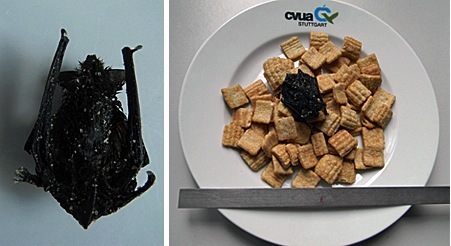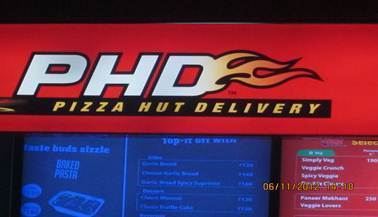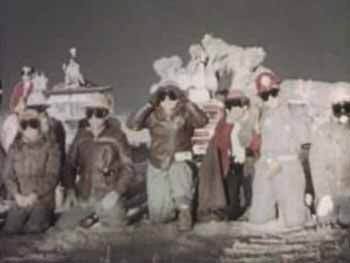Marc Abrahams's Blog, page 536
November 11, 2012
Die Fledermaus in the breakfast cereal
Chemischen und Veterinäruntersuchungsämter (CVUA) in Stuttgart, Germany, issued a report about a recent investigation. Translated (automatically, by Google) into English, it begins:
Surprise at breakfast
A report from our laboratory work
Consumers found mummified bat in wholegrain wheat flakesA curious appeal trial was recently presented to us: consumers had in their “mini Zimties whole wheat flakes” discovered a foreign object and realize upon closer inspection, it is indeed a well-preserved and completely dried bat. On the one hand appalled and aware that this is not this is a Halloween joke and that afford the manufacturer neither hygienic nor any other respect, to disappear in any Vollkornflakes-carton a bat, they delivered the cereal box along with their desirable and undesirable content dutifully from the relevant competent Food Inspection Agency. There it was necessary to determine where and how the animal may have come in the package and whether any further danger ausginge by the operation. For this protocol, and sample was sent to the CVUA Stuttgart.
There, the gruesome discovery was confirmed as that which already suspected the complainant: actually a surviving bat had come into the inner bag of the cereal box, which proved the addition found between the square flakes Kotbröckchen bat.
However, the Protocol also brought to light that the package was in high summer August purchased and opened stored for weeks in an open kitchen board….
(Thanks to investigator Kees Moeliker for bringing this to our attention.)

Life-saving brassieres: Yet another example
The history of life-saving brassieres has yet another chapter, this one a first-person narrative written by Jessica Bruinsmain in The Guardian:
Experience: My bra saved my life‘I crashed against rock, barely stopping myself from rolling straight off the ledge into the valley below’…
The previous chapter — a chapter still unfolding — concerns Dr. Elena Bodnar‘s Chernobyl-inspired (and eventually, Ig Nobel Prize-winning) invention of the Emergency Bra.
BONUS: A second-hand account, by the Associated Press, of the Bruinsmain bra saga.
BONUS: Video of Dr. Bodnar accepting her Ig Nobel Prize in 2009, and demonstrating the invention with the assistance of three Nobel laureates:

Kurt Verkest joins hair club for scientists (LFHCfS)
Kurt Verkest has joined the Luxuriant Flowing Hair Club for Scientists (LFHCfS). He says:
I grew my hair to my mother’s annoyance 20 years ago, but it grew on me, so I keep it growing even though it no longer annoys her.
Kurt Verkest, BVSc, BVBiol, MANZCVS, PhD, LFHCfS
Director of Veterinary Education and Consultant in Oncology
Pets Central
Hong Kong


November 10, 2012
Some abdominal muscles: how to use them with coins
November 9, 2012
How to dismantle a bicycle, theft by theft
The maker of this short video explains: “Last year, Red Peak Branding conducted a unique urban experiment for Hudson Urban Bicycles. On January 1, 2011 we chained a fully loaded bike – bells, basket, lights and more – to a post along a busy Soho street. We took a picture of the bike everyday for 365 days, watching it slowly vanish before our eyes.”
(Thanks to investigator Johanna Little for bringing this to our attention.)

Meth is Nothing to Sneeze At: A Possible Anti-Influenza Agent
Drugs almost always have more than one effect on the body. Witness this new study:
“Methamphetamine Reduces Human Influenza A Virus Replication,” Yun-Hsiang Chen, Kuang-Lun Wu, Chia-Hsiang Chen [pictured here], PLoS ONE 7(11): e48335. (Thanks to investigator Ron Josephson for bringing this to our attention.) The authors, at the National Health Research Institutes in Zhunan, Taiwan, and Chang Gung University School of Medicine in Taoyuan, Taiwan, report:
“Methamphetamine (meth) is a highly addictive psychostimulant that is among the most widely abused illicit drugs, with an estimated over 35 million users in the world…. However, little is known about whether meth has the ability to enhance influenza A virus replication, thus increasing severity of influenza illness in meth abusers…. We report the first evidence that meth significantly reduces, rather than increases, virus propagation and the susceptibility to influenza infection in the human lung epithelial cell line… these findings prompt the study to examine whether other structurally similar compounds could be used as anti-influenza agents.”

Improbable Research Reports @ the Berkman Center
Join us for an Improbable public event at an interesting place (and webcast on the net):
berkman luncheon series >[Nov 13] This is Improbable
Featuring Marc Abrahams and other special guestsTuesday, November 13, 12:30 pm
Harvard Law School, Wasserstein Hall, Milstein West B Room
RSVP required for those attending in person [via a simple form]
This event will be webcast live at 12:30pm ET and archived on our site shortly afterMarc Abrahams — editor of the Annals of Improbable Research, host of the annual Ig Nobel Prize Ceremony, and author of several books (including his latest, This is Improbable: Cheese String Theory, Magnetic Chickens and Other WTF Research –listen to Marc’s NPR interview) — will be joining us for a lively exploration of weird science, off-beat research, and things that go bump in the lab. Members of the Berkman Center community will join with a group of special guests to perform dramatic readings from bizarre studies discussed in Marc’s new book, and answer questions about what they have read based on no special knowledge whatsoever. Does it sound odd? Yes. Does it actually work? Surprisingly well.
Featuring:
Gus Rancatore (proprietor, Toscanini’s Ice Cream)
Richard Baguley (technology reviewer)
Naomi Stephen (literature scholar)
Jeff Hermes (director, Digital Media Law project)
Mary Carmichael (higher ed reporter, Boston Globe)
Molly Sauter, Berkman Center Fellow
Ryan Budish, Berkman Center Fellow and Director of Herdict
Judith Donath, Berkman Center Fellow
Kendra Albert, Berkman Center Fellow
Alicia Solow-Niederman, Berkman Center Staff
Matthew Battles, Berkman Center Fellow
Adam Holland, Berkman Center Staff
others to be announced

PHD = pizza, sometimes
Sometimes, in some places, PhD means “doctor of philosophy”.
Sometimes, in some places, PHD means pizza. One of those places, call of the time, is Malaysia, the base of operations for the company for which the letters P, H, and D stand for “Pizza Hut Delivery“.
(Thanks to investigator Elaine Snell for bringing this to our attention.)

November 8, 2012
Atomic Bomb v. Cod Fillets (1955 study)
 A few cartons of Birds Eye frozen cod fillets sit in the freezer of a small house in southern Nevada, US. It’s 4 in the morning. Suddenly, an agonisingly bright light sears through the kitchen – a 39 kiloton nuclear bomb has detonated just 400 metres away…
A few cartons of Birds Eye frozen cod fillets sit in the freezer of a small house in southern Nevada, US. It’s 4 in the morning. Suddenly, an agonisingly bright light sears through the kitchen – a 39 kiloton nuclear bomb has detonated just 400 metres away…
Question:What happens to the cod fillets?
We are in a good position to make an informed guess, thanks to a US Govt. experimental study which empirically tested that very scenario. At 4:10 am May 5th, 1955, a nuclear bomb assigned to ‘Operation Cue’ (a.k.a. ‘Apple-2’) was detonated at Area 1 of the Nevada Test Site. Packs of frozen cod fillets, along with frozen chicken pot pie, frozen french fried potatoes, and other chilled foods were exposed to the effects of the bomb at distances of 1270, 2750, 4700 and 10,500 feet from ‘Ground Zero’. The subsequent report into their post-blast condition, which was written by consultant Herman P. Schmitt, found that :
“Frozen food samples from the stations at 1270 and 2750ft were found to be definitely radioactive, particularly the cod fillets.”
Nevertheless* they were ;
“Tasted by a panel of quality-control experts and executives of the frozen-food industry at the Town House in Los Angeles on May 10, 1955.”
“Recovered samples were found to be free of physical and thermal damage. Kinaesthetic evaluations proved the retention of flavor, color, appearance and texture.“
The report did note though that radioactively ‘hot’ frozen cod fillets should probably only be consumed in an emergency situation.
The official document can be read in full here : EFFECTS OF NUCLEAR EXPLOSIONS ON FROZEN FOODS
BONUS . . .
A public information video (which somehow combines the look-and-feel of a propaganda exercise with a surrealistic art-movie) documented Operation Cue, and can be viewed here:
Notes:
* [1] The report does not forget to thank the team which tasted the radioactive samples :
“A vote of tribute is accorded all these fine people for their splendid services to a project undertaken in the public interests and for the national defense.”
[2] Improbable checked, but Birds Eye really doesn’t have an apostrophe – the firm was named after its founder, Mr. Clarence Frank Birdseye II

November 7, 2012
Thanks for the Activated Sludge
Kindly wishes, from the preface of the book Sewerage and Sewage Treatment, by Harold Eaton Babbitt (published by John Wiley and Sons, New York,1922):
[The author wishes to express his thanks] to Mr. Paul Hansen, consulting engineer, of Chicago, and to Mr. Langdon Pearse, Sanitary Engineer of the Sanitary District of Chicago, for their help on the section covering the treatment of sewage; and to Professor Edward Bartow, Professor of Chemistry at the University of Iowa, for his review of the chapter on Activated Sludge; in general his thanks are due to all others who have furnished suggestions, illustrations, or quotations, acknowledgments of which have been included in the text.

Marc Abrahams's Blog
- Marc Abrahams's profile
- 14 followers




























